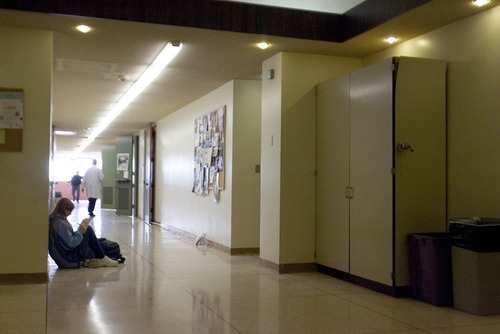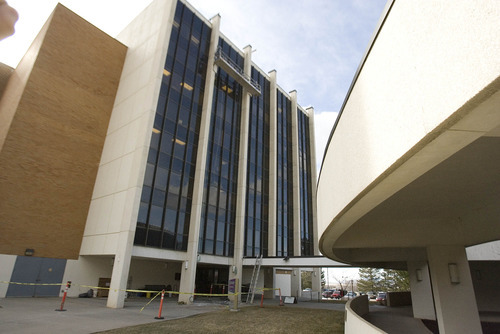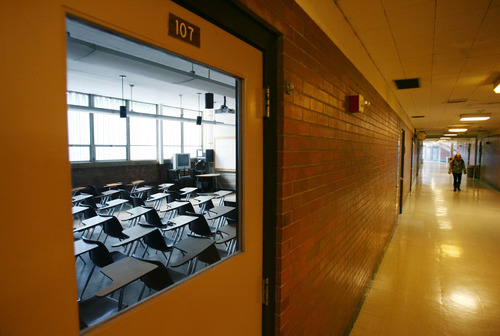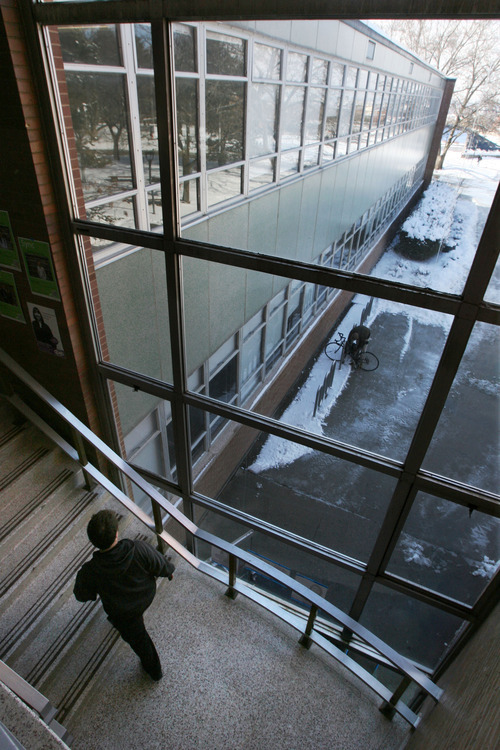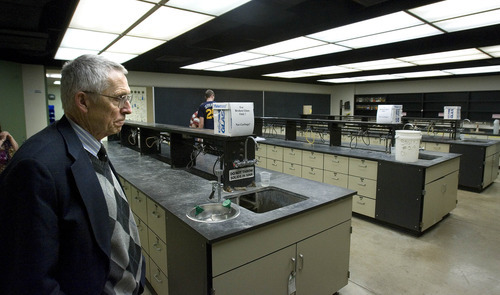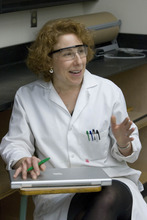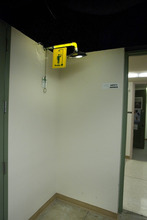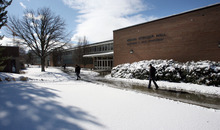This is an archived article that was published on sltrib.com in 2012, and information in the article may be outdated. It is provided only for personal research purposes and may not be reprinted.
Ogden • The floor under the shower head says it all.
There is no hole to drain the water that would rain down if someone rushed to rinse off dangerous chemicals.
In Weber State University's Science Lab Building, the fume hoods don't suck air (a bad thing), and no one bothered to install a sprinkler system (even worse). Chemistry students have nowhere to study except in the halls, where officials recently removed the chairs because of fire-safety concerns. If these problems weren't bad enough, the chemistry labs are on the fifth floor.
"Now a chemistry department can't be above the third floor" because of fire codes, said chemistry professor Spencer Seager, who has been teaching at Weber since 1961. "A chemistry floor without a sprinkler system? Today that would be illegal."
Relief could be on the way. Weber's $63 million request to replace the 1969 science building is on the bubble as lawmakers firm up the state budget this week. But this building is just the tip of a billion-dollar iceberg waiting for taxpayers in coming years as dozens of college buildings continue to deteriorate.
The problem is compounded by design and structural standards that scraped rock bottom in the 1960s, just as campuses around the country embarked on a massive building spree to accommodate the baby boom surge in college-age adults. These buildings have now reached the end of their relatively short design lives, and proposals are stacking up to replace and renovate them.
Over the past decade Utah schools, particularly the University of Utah, have been grappling with the high cost of cheap construction that was endemic 40 to 50 years ago. Chronic problems include leaky water lines and inefficient ventilation systems that drive up utility and maintenance costs and render buildings uncomfortable, even unusable. The U. and other schools have been spending millions on temporary fixes and repairing leak damage.
—
Wear your coat • The U. has moved forward on many projects, such as costly renovations to the College of Nursing and the Marriott Library. But there is much left to fix, according to Michael Perez, associate vice president for facilities management.
"We've been taking stabs at eating away this. It is overwhelming. We will have ongoing challenges for many years," Perez said.
On the hit list are three of the U.'s most intensively used buildings: the School of Medicine, the law school and Orson Spencer Hall, or OSH.
OSH, which houses the political science and geography departments, is named for the Mormon pioneer who became the U.'s first president in 1850. It is the U.'s largest classroom building, and yet the heating and air-conditioning systems often malfunction, according to longtime geography professor Harvey Miller.
"I saw students taking final exams last semester wearing winter coats it was so cold," Miller said. "I have been forced out of my office half a dozen times this year. I understand the financial bind the university is in. Our per-student funding is pretty low. I feel bad for the staff and the students. I have more flexibility because I can go to the library."
Nor can OSH accommodate today's technology-driven instruction, in which students work in teams rather than stare at a lecturer and content is delivered digitally, Perez noted. The U. envisions a $43 million renovation, but officials are neither sure how to get the money or where to relocate OSH's many classes and offices while the work is done.
Similar concerns await the U. when it replaces the 600,000-square-foot School of Medicine. Other anticipated renovations include the 1970 art and architecture complex and Bennion Hall.
—
Saving vs. razing • Few mourned the loss of the U.'s Garff building, torn down over the holiday break to make way for the second phase of the new business complex. But campus aesthetics require saving older iconic buildings, although they pose additional challenges related to historic preservation, seismic safety, inadequate floor-to-ceiling clearance and asbestos removal.
Many buildings huddled around the U.'s Presidents Circle predate the 1960s by decades. The Life Sciences, Performing Arts and Stewart buildings need remodeling, but only the George Thomas Building, the erstwhile home of the Natural History Museum of Utah, is slated for an upgrade. Thanks to massive pledges, Thomas will be renovated and expanded to house the College of Science and the new Center for Cell and Genome Science.
The David Eccles School of Business and S.J. Quinney College of Law have also lined up funding to replace their 1960s-era homes. The law school hopes to secure legislative approval this week to move forward with its $60.5 million proposal to build a cutting-edge facility on the southwest corner of campus. Quinney's existing building has jeopardized the law school's accreditation for a decade.
"We've had harsh assessments of the building from our external accreditors," said law dean Hiram Chodosh. "They rave about our programs, but note that our building doesn't match our program."
On campuses around the nation, cinder-block dormitories are being bulldozed into memory. Southern Utah University's 1964 Juniper Hall was condemned last year because its failure-prone hot-water lines are encased under concrete and not accessible. Student residents had to vacate in mid-semester. The U. replaced its dismal dorms a decade ago with inviting residence halls at Fort Douglas, a task the private Brigham Young University is undertaking.
BYU also plans to raze its 1968 Widtsoe building, the nine-story home of the College of Life Sciences after its replacement is completed. Westminster College, the state's other private school, is dropping $1.4 million this summer to renovate its windowless 1964 Nightingale building into a new Student Commons, which will feature lots of glass.
Weber's science building isn't the only one on the Ogden campus needing a makeover, but the others will have to wait while funds are raised, according to Norm Tarbox, vice president for administrative services.
Next up is the Social Science Building, which officials hope to renovate with $22 million in private money. But the new science building can't come fast enough for science students and chemistry professor Michelle Paustenbaugh, who recently pointed out her labs' deficiencies, including low ceilings and dilapidated cabinets that are supposed to keep chemicals secure.
"Why do you want to learn science if this is the type of environment you'll be learning in?" she asked.
Building bust
A Utah legislative appropriations subcommittee is recommending funding for up to $214 million in construction projects on seven higher education campuses. Ranked in priority, they include:
U. of U. utility infrastructure • $38 million
UVU classroom building • $53.2 million
Southwest ATC • $15.8 million
Weber science building • $63.2 million
USU Brigham City campus • $7.5 million
USU-Eastern arts building • $23.8 million
Snow science remodel • $12.3 million
The committee also recommends approving several campus projects that would be built with non-state funds:
U. of U. dental school • $37.4 million
USU San Juan campus student housing • $4 million
Weber Stromberg addition • $8 million
Weber social science building remodel • $22 million
U. of U. Law School replacement • $60.5 million



